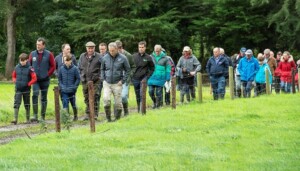Was war die Herausforderung/das Problem, das angegangen wurde?? Why is it important for partnership to solve the problem?
A poor level of a full understanding among farmers and the the wider agricultural industry of what the key components were to make dairy calf to beef systems profitable and sustainable
Wie hast du das Problem gelöst? (Oder wenn Ihr Praxisfall noch in Bearbeitung ist, wie lösen Sie das Problem?)
The Teagasc Green Acres Demonstration Farm Programme was established in 2015 and operated for two phases of three years each. The programme had 10 zu 12 demonstration farms that were implementing best practice in their dairy calf to beef enterprises through an intensive advisory service that was provided to them by Teagasc. They also received a large amount of advice and support from the six commercial companies that provided funding for the programme. The primary output from the programme was the production of a significant amount of knowledge transfer material that could be used by Teagasc staff (zu machen. / specialists / Forscher) and the industry to show all beef farmers how the uptake of technologies on their farms would lead to an increase in their profitability per hectare. This knowledge transfer material included a large number of articles for printing in the farming press, articles for publication on a digital farming news portal, technical factsheets for distribution to farmers, technical videos, open days to the public on the farms, discussion group days on the farms and the collection of a large amount of financial data on a number of different dairy calf to beef systems.
Was ist in Ihrem Praxisfall innovativ? (z.B. technische Innovation, neue Produkte oder Dienstleistungen, Markt
Innovationen, soziale/organisatorische Innovationen etc.)
• Monthly Teagasc articles in the Farming Independent (a national agri newspaper with a very large readership) von 2015 zu 2018 on different topics that influence the profitability of dairy calf to beef systems.
• 3 – 4 farm walks per annum on participating demonstration farms.
• Training provided on dairy calf to beef topics to the staff of the commercial companies that helped to fund the programme.
• Training provided to Teagasc beef advisors on the key learnings that came from working with the demonstration farmers. This material could then be used with their own beef discussion groups and with individual clients.
• Regular updates on the lessons learnt from the programme in Teagasc monthly newsletters and in the Teagasc bi-monthly Today’s Farm magazine, both of which are distributed to 40,000 clients.
• In the second phase of the programme the digital farming news platform AgriLand was used considerably to transfer the knowledge generated within the programme to a wider audience of farmers. As an example in 2019 there were 62 online articles, 18 online videos and 450,000 recorded reads. Again this is a national agri-news online platform with a very large audience.
• In the second phase of the programme there were six fact sheets produced per annum on dairy calf to beef topics. Each fact sheet covered a relevant topic in detail across two A4 pages.
Was sind Erfolgsfaktoren bei der Lösung des Problems??
• Through working closely with the five commercial funding companies in phase one (2015 -2018) of the programme and the six companies in phase two of the programme (2018 – 2021) Teagasc has built and improved the working relationship with each of these companies.
• The companies that were asked to contribute funding to the programme were all involved in supplying inputs to dairy calf to beef farmers and had technical expertise in their own areas of work. This included animal health, soil fertility, animal nutrition, animal breeding and the use of herbicides. This technical expertise was used throughout both phases of the programme with the demonstration farmers, at public farm walks, with Teagasc advisors and in some of the knowledge transfer material produced by the programme. By using this expertise it broadened the avenues through which the key messages of the programme were delivered.
• By working closer with the Farming Independent as media partner in the first phase and AgriLand in the second phase, the Teagasc staff working on the programme gained valuable experience on how best to use both these channels of agri-media to improve the dissemination of key technical messages to a wide audience of farmers.
• All six of the funders of the second phase of the Teagasc Green Acres programme have as a result of their successful involvement in the programme, signed up to fund a new dairy calf to beef campaign in Teagasc for a five year period (with increased funding) . This campaign is called the DairyBeef 500 campaign which is also under the umbrella of the new Teagasc Signpost Programme that involves commercial companies from across the agri-industry sponsoring a programme to encourage all Irish farmers to reduce Green House Gas (Treibhausgas) emissions. Without their involvement in two phases of the Teagasc Green Acres programme is it highly unlike that they would have become involved in either of these programmes.
Gewonnene Erkenntnisse.
– Time needs to be allocated to disseminating the good work that is achieved on the demonstration farms by both the advisors and the farmers.
– Farmers react much better to watching short videos of what is happening on the demo farms than to reading large articles.
– Short two page fact sheets work well for explaining relatively complex concepts once they are well lid out with tables, graphs, text and relevant photos.
-Working with commercial companies towards a common goal is good for both the Knowledge Transfer Broker and the commercial companies. There are many areas we can collaborate on to use our relevant strengths and expertise and the networking element for both the advisors working on the programme and the farmers is invaluable.
– Online digital media platforms that provide free to air articles to farmers is an excellent method for knowledge transfer when we work together.
Welche Rolle spielt der Berater bzw. die Beratungsstelle in Ihrem Praxisfall?
The advisor and the advisory service plays a central role in the success of my example. The advisor who works full-time on the programme is the key to getting innovation implemented on the demonstration farms and to start the dissemination process. The local agricultural advisor in the area then uses the information generated on these farms and their success stories (as well as failure stories) to show this to the rest of their client list. This is how we multiply the impact of the demonstration farms across a very wide number of farms thorough the large number of local advisors who take advantage of the information generated.


Für den Austausch der Erfahrungen mit der guten Praxis, Für alle Fragen und Anfragen zu den kommenden Excellence-Klassen
Pearse Kelly, pearse.kelly@teagasc.ie
https://www.teagasc.ie/animals/beef/demonstration-farms/previous-programmes/green-acres-calf-to-beef/
